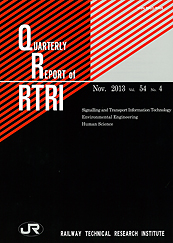Volume 54, Issue 4
Displaying 1-9 of 9 articles from this issue
- |<
- <
- 1
- >
- >|
PAPERS
-
2013Volume 54Issue 4 Pages 197-201
Published: November 01, 2013
Released on J-STAGE: December 05, 2013
Download PDF (904K) -
2013Volume 54Issue 4 Pages 202-207
Published: November 01, 2013
Released on J-STAGE: December 05, 2013
Download PDF (477K) -
2013Volume 54Issue 4 Pages 208-213
Published: November 01, 2013
Released on J-STAGE: December 05, 2013
Download PDF (1179K) -
2013Volume 54Issue 4 Pages 214-221
Published: November 01, 2013
Released on J-STAGE: December 05, 2013
Download PDF (1438K) -
2013Volume 54Issue 4 Pages 222-230
Published: November 01, 2013
Released on J-STAGE: December 05, 2013
Download PDF (5869K) -
2013Volume 54Issue 4 Pages 231-236
Published: November 01, 2013
Released on J-STAGE: December 05, 2013
Download PDF (1585K) -
2013Volume 54Issue 4 Pages 237-242
Published: November 01, 2013
Released on J-STAGE: December 05, 2013
Download PDF (4063K) -
2013Volume 54Issue 4 Pages 243-248
Published: November 01, 2013
Released on J-STAGE: December 05, 2013
Download PDF (1526K) -
2013Volume 54Issue 4 Pages 249-253
Published: November 01, 2013
Released on J-STAGE: December 05, 2013
Download PDF (4907K)
- |<
- <
- 1
- >
- >|
